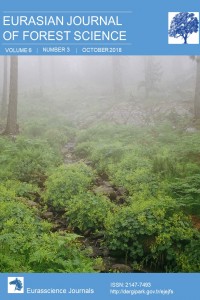TLC and GC-MS analysis of fermented wood "Nikhra" petroleum ether fraction of Combretaceae spp. Combretum hartmannianum and Terminalia laxiflora
Öz
This study aims to analysis
fractions (petroleum ether, chloroform,
methanol and
aqueous) fermented
wood Nikhra of Combretaceae spp (Combretum hartmannianum and Terminalia laxiflora) analysis it by using
chromatographic and spectroscopic analysis. Petroleum ether Nikhra fraction analysis with TLC and spray TLC with
vanillin H2SO4
(pink) (B1, B2), Rf values (0.84, 0.81), were expected to be phenolic, with vanillin HCL (red)
compounds spots (B2) with Rf values (0.81) was expected to be catechin and with vanillin H3PO4,
blue-violet zones compounds spots
(A1, A2, A3), (B1, B2, B3, B4), with Rf values (0.88, 0.78, 0.67), (0.84, 0.81, 0.67, 0.59), respectively
were expected to be lignans. Petroleum ether
fermented
wood"Nikhra" fraction was divided into two types of compounds
classes aromatic and non aromatic by and hence
compounds were classified to phenolics and terpenoids
compounds by
GC/MS.
Fragrant aromatics or terpenoids were targeted in this part of study. GC-MS
analysis gave a spectrum of fragrance aromatic compounds (phenolics) in the
petroleum ether Nikhrafractions of T. laxiflora, was
Lup-20(29)-en-3-ol, acetate, (3β) and Tetracosamethyl-cyclododecasiloxane, main
terponoids compounds was eicosamethylcyclodecasiloxane. Main fragrance aromatics compounds in the petroleum ether Nikhra fraction of C. hartmannianum was 2-tert-Butyl-5-(hydroxtmethyl)-4-formylfuran,
and main terponoids compounds was Tetracosamethylcyclododecasiloxane.
Anahtar Kelimeler
Combretaceae Combretum hartmannianum Terminalia laxiflora Gas Chromatography
Kaynakça
- Abbiw, D. K. (1990). "Useful plants of Ghana: West African uses of wild and cultivated plants," Intermediate Technology Publications and The Royal Botanic Gardens. Journal of Tropical Ecology 7 286-287
- Ali, H., König, G., Khalid, S., Wright, A., and Kaminsky, R. (2002). Evaluation of selected Sudanese medicinal plants for their in vitro activity against hemoflagellates, selected bacteria, HIV-1-RT and tyrosine kinase inhibitory, and for cytotoxicity. Journal of ethnopharmacology 83, 219-228.
- Batawila, K., Kokou, K., Koumaglo, K., Gbeassor, M., De Foucault, B., Bouchet, P., and Akpagana, K. (2005). Antifungal activities of five Combretaceae used in Togolese traditional medicine. Fitoterapia 76, 264-268.
- Daniel, K. A. (1990). Useful plants of Ghana: West African uses of wild and cultivated plants. Intermediate Tech. Pub. Ltd and Royal Botanic Gardens, Kew, 337.
- Doka, I., and Yagi, S. (2009). Ethnobotanical survey of medicinal plants in west Kordofan (Western Sudan). Ethnobotanical Leaflets 2009, 8.
- Fyhrquist, P., Mwasumbi, L., Hæggström, C.-A., Vuorela, H., Hiltunen, R., and Vuorela, P. (2002). Ethnobotanical and antimicrobial investigation on some species of Terminalia and Combretum (Combretaceae) growing in Tanzania. Journal of Ethnopharmacology 79, 169-177.
- Mariod, A. A., Mohammed, N. M. F., Nabag, F. O., and Hassan, A. A. (2014). Ethnobotanical study of three trees: indigenous knowledge on trees used as cosmetic in Khartoum State, Sudan. Eur. J. Mol. Biol Biochem. 1 (2): 77-80
- Wagner, H., and Bladt, S. (1996). Plant drug analysis: a thin layer chromatography atlas, Springer Science & Business Media.
Öz
Kaynakça
- Abbiw, D. K. (1990). "Useful plants of Ghana: West African uses of wild and cultivated plants," Intermediate Technology Publications and The Royal Botanic Gardens. Journal of Tropical Ecology 7 286-287
- Ali, H., König, G., Khalid, S., Wright, A., and Kaminsky, R. (2002). Evaluation of selected Sudanese medicinal plants for their in vitro activity against hemoflagellates, selected bacteria, HIV-1-RT and tyrosine kinase inhibitory, and for cytotoxicity. Journal of ethnopharmacology 83, 219-228.
- Batawila, K., Kokou, K., Koumaglo, K., Gbeassor, M., De Foucault, B., Bouchet, P., and Akpagana, K. (2005). Antifungal activities of five Combretaceae used in Togolese traditional medicine. Fitoterapia 76, 264-268.
- Daniel, K. A. (1990). Useful plants of Ghana: West African uses of wild and cultivated plants. Intermediate Tech. Pub. Ltd and Royal Botanic Gardens, Kew, 337.
- Doka, I., and Yagi, S. (2009). Ethnobotanical survey of medicinal plants in west Kordofan (Western Sudan). Ethnobotanical Leaflets 2009, 8.
- Fyhrquist, P., Mwasumbi, L., Hæggström, C.-A., Vuorela, H., Hiltunen, R., and Vuorela, P. (2002). Ethnobotanical and antimicrobial investigation on some species of Terminalia and Combretum (Combretaceae) growing in Tanzania. Journal of Ethnopharmacology 79, 169-177.
- Mariod, A. A., Mohammed, N. M. F., Nabag, F. O., and Hassan, A. A. (2014). Ethnobotanical study of three trees: indigenous knowledge on trees used as cosmetic in Khartoum State, Sudan. Eur. J. Mol. Biol Biochem. 1 (2): 77-80
- Wagner, H., and Bladt, S. (1996). Plant drug analysis: a thin layer chromatography atlas, Springer Science & Business Media.
Ayrıntılar
| Birincil Dil | İngilizce |
|---|---|
| Bölüm | Articles |
| Yazarlar | |
| Yayımlanma Tarihi | 26 Ekim 2018 |
| Gönderilme Tarihi | 19 Nisan 2018 |
| Yayımlandığı Sayı | Yıl 2018 Cilt: 6 Sayı: 3 |


